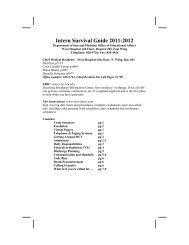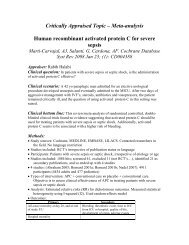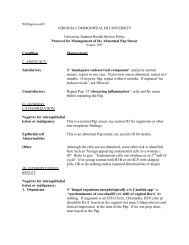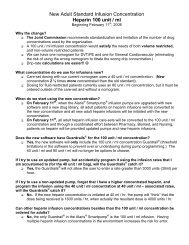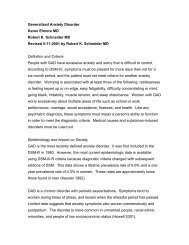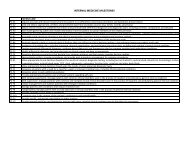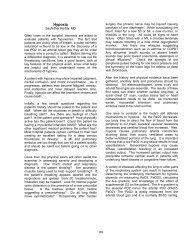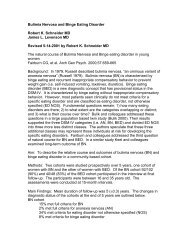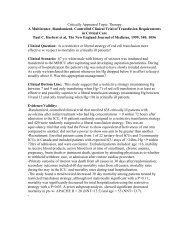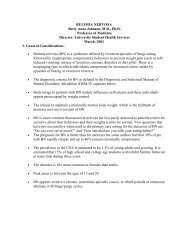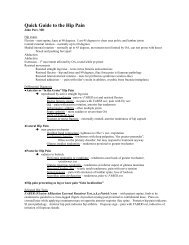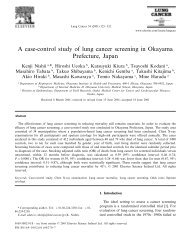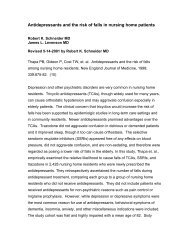Withdrawal from Alcohol, Cocaine, and Heroin
Withdrawal from Alcohol, Cocaine, and Heroin
Withdrawal from Alcohol, Cocaine, and Heroin
Create successful ePaper yourself
Turn your PDF publications into a flip-book with our unique Google optimized e-Paper software.
<strong>Withdrawal</strong> <strong>from</strong> <strong>Alcohol</strong>, <strong>Cocaine</strong>,<br />
<strong>and</strong> <strong>Heroin</strong><br />
Michael Weaver, MD<br />
Up to 40 percent of hospital admissions are related<br />
to problems of substance abuse. 1 Patients who<br />
abuse alcohol or drugs may be admitted to the<br />
hospital for trauma or another medical problem, then<br />
develop an acute withdrawal syndrome while<br />
inpatient. Recognition <strong>and</strong> treatment of the<br />
appropriate withdrawal syndrome is important to<br />
prevent excess mortality or prolonged hospitalization<br />
due to complications.<br />
<strong>Alcohol</strong> <strong>and</strong> Sedative-Hypnotic Medications<br />
Sedative-hypnotic drugs include alcohol,<br />
benzodiazepines, barbiturates, <strong>and</strong> other sleeping<br />
pills. This type of prescription medication has<br />
significant potential for abuse. It is unusual to see<br />
patients who are solely abusing prescription<br />
medication. The majority of sedative-hypnotic<br />
abusers take one or more benzodiazepines <strong>and</strong><br />
ethanol, along with barbiturates <strong>and</strong> other sleeping<br />
pills.<br />
Signs of <strong>Withdrawal</strong> – The withdrawal syndrome<br />
manifests with the same signs <strong>and</strong> symptoms for<br />
alcohol or any of the other sedative-hypnotic<br />
medications. This consists of escalating autonomic<br />
instability that usually begins within 48 hours of the<br />
last drink, although many of the benzodiazepines<br />
have long-acting metabolites, so the patient may not<br />
show signs of withdrawal for 7 to 10 days after<br />
stopping all drugs. The signs of the withdrawal<br />
syndrome are presented in Table 1; progression to<br />
severe withdrawal carries a significant mortality, so<br />
early recognition <strong>and</strong> treatment is essential.<br />
Treatment of mild to moderate withdrawal —<br />
Treatment is identical for withdrawal <strong>from</strong> all<br />
sedative-hypnotics, including barbiturates, sleeping<br />
pills, benzodiazepines, <strong>and</strong> alcohol. All drugs in<br />
these categories exhibit cross-dependence.<br />
The first step is to objectively determine an<br />
approximate level of drug to which the patient is<br />
tolerant; patients tend to over- or underestimate the<br />
amount of alcohol or other drug they have been<br />
taking. Very precise instruments for the<br />
measurement of tolerance exist, but often are not<br />
practical <strong>and</strong> in many cases are not necessary.<br />
While any medication with cross-dependence can be<br />
used, a scheme for using phenobarbital follows: 2<br />
• An initial dose is given, usually 60 to 90 mg of<br />
phenobarbital (or an equivalent dose of another<br />
sedative-hypnotic such as diazepam or clonazepam,<br />
see Table 2), <strong>and</strong> the patient is monitored for at<br />
least 6 to 8 hours.<br />
• The withdrawal drug is repeated at hourly or twohour<br />
intervals as indicated by the signs of withdrawal<br />
the patient is exhibiting.<br />
• After 8 hours, an approximation can be made of<br />
the total dose the patient will require for a 24-hour<br />
period. It is better to err on the side of slightly overrather<br />
than undermedicating.<br />
Tapering is started <strong>from</strong> the dose calculated above.<br />
Reducing the dose by 10 percent of the initial dose<br />
each day provides a comfortable taper, especially if<br />
the patient has coexisting medical conditions. The<br />
taper can be accomplished more rapidly if these<br />
conditions do not exist.<br />
Long-acting medications decrease the severity of<br />
withdrawal symptoms; phenobarbital may be chosen<br />
in preference to other sedatives since it has a longer<br />
half-life than diazepam, patients rarely achieve a<br />
"high" <strong>from</strong> phenobarbital as they do <strong>from</strong> the other<br />
drugs, <strong>and</strong> it is available in multiple dosage forms.<br />
The dose of phenobarbital can be given in a<br />
constant volume of liquid for each dose so the<br />
patient is not aware of the amount being decreased<br />
each day ("blind taper").<br />
Anticonvulsant agents that do not show crossdependence<br />
with sedative-hypnotics (carbamazepine,<br />
valproate) have been used successfully in<br />
the treatment of mild sedative-hypnotic withdrawal. 3<br />
They are given at full anticonvulsant doses for<br />
several weeks. These medications have not been<br />
studied for use in severe withdrawal.<br />
Treatment of advanced withdrawal (“Delirium<br />
Tremens”)— Advanced sedative-hypnotic withdrawal<br />
(e.g., markedly abnormal vital signs, delirium) should<br />
be treated rapidly <strong>and</strong> with sufficiently large doses of<br />
medication to suppress the withdrawal. Medications<br />
with a rapid onset of action should be used <strong>and</strong> may<br />
be given intravenously for immediate effect.<br />
Lorazepam <strong>and</strong> diazepam are good choices since<br />
they have a rapid onset of action when given<br />
intravenously, although they have a shorter duration<br />
of action than when given orally since first-pass liver<br />
metabolism is bypassed. For example, give<br />
lorazepam 1-4 mg intravenously every 10-30<br />
minutes until the patient’s agitation or delirium<br />
improves so that the patient is calm but awake, <strong>and</strong><br />
78
the heart rate decreases to around 100<br />
beats/minute.<br />
After stabilization with rapid-acting medications, the<br />
patient can be switched to an equivalent dose of a<br />
long-acting medication such as phenobarbital, oral<br />
diazepam, or clonazepam. The awake patient will<br />
not undergo significant respiratory depression <strong>from</strong><br />
the withdrawal medication; at times very large doses<br />
are required (up to 700 mg of phenobarbital per<br />
day).<br />
<strong>Cocaine</strong> <strong>and</strong> Other Stimulants<br />
Stimulants are drugs that stimulate the central<br />
nervous system (CNS) to produce increased<br />
psychomotor activity. Amphetamines <strong>and</strong> cocaine<br />
are the most prevalent stimulants abused. <strong>Cocaine</strong><br />
is a short-acting local anesthetic with marked<br />
stimulant effects.<br />
Signs of <strong>Withdrawal</strong> — An abstinence syndrome can<br />
occur with chronic stimulant use that is characterized<br />
by symptoms that are more subtle <strong>and</strong> complex than<br />
those previously associated with drug withdrawal.<br />
The "crash," or drastic reduction in mood <strong>and</strong><br />
energy, starts 15 to 30 minutes after cessation of a<br />
stimulant binge. Addicts experience craving,<br />
depression, anxiety, <strong>and</strong> paranoia. The craving for<br />
stimulants decreases over one to four hours <strong>and</strong> is<br />
replaced by a craving for sleep <strong>and</strong> rejection of<br />
further stimulant use. Hypersomnolence lasts eight<br />
hours to four days. Sleep is punctuated by brief<br />
awakenings during which the addict experiences<br />
hyperphagia ("the munchies"). Then begins a<br />
protracted dysphoric syndrome in which the addict<br />
experiences anhedonia, boredom, anxiety,<br />
generalized malaise, problems with memory <strong>and</strong><br />
concentration, <strong>and</strong> occasional suicidal ideation. This<br />
induces severe craving that may lead to resumption<br />
of stimulant use <strong>and</strong> a vicious cycle of recurrent<br />
binges. Intermittent conditioned craving can last<br />
months to years after the last stimulant use, <strong>and</strong> is<br />
gradually extinguished over time. The severity <strong>and</strong><br />
duration of withdrawal depends upon the intensity of<br />
the preceding months of chronic abuse <strong>and</strong> the<br />
presence of predisposing psychiatric disorders,<br />
which amplify withdrawal symptoms.<br />
If marked depression persists longer than one week<br />
after withdrawal, the patient should be evaluated<br />
carefully to determine if he or she is "selfmedicating"<br />
an underlying depression, which then<br />
should be treated with a specific antidepressant.<br />
Treatment — Abrupt discontinuation of stimulants<br />
does not cause gross physiologic sequelae. Thus,<br />
they generally are not tapered or replaced with a<br />
cross-tolerant drug during medically supervised<br />
withdrawal. Propranolol may be effective in reducing<br />
severe cocaine withdrawal symptoms, 4 but may<br />
aggravate cocaine-induced hypertension or coronary<br />
artery vasoconstriction. 5<br />
<strong>Heroin</strong> <strong>and</strong> Other Opioids<br />
Opioids are used therapeutically as analgesics, <strong>and</strong><br />
heroin is an opioid with significant potential for<br />
abuse.<br />
Signs of <strong>Withdrawal</strong> — Opioid-dependent patients<br />
experience withdrawal symptoms when the drug is<br />
discontinued. See Table 3 for a list of opioid<br />
withdrawal signs. Abrupt withdrawal usually causes<br />
physical effects no worse than a bad case of<br />
influenza. However, this form of therapy is not<br />
justifiable because of the extreme anxiety<br />
experienced by opioid users upon sudden drug<br />
cessation.<br />
Treatment—Virtually any opioid can be administered<br />
to relieve acute withdrawal symptoms. The effects of<br />
short-acting medications (e.g., morphine,<br />
hydromorphone) can be controlled precisely but<br />
require frequent assessment <strong>and</strong> dose adjustment,<br />
<strong>and</strong> patients may experience severe withdrawal<br />
symptoms toward the end of the dosing period.<br />
Short-acting medications are most appropriately<br />
used in intensive care units or in other situations<br />
when the patient's condition is likely to change<br />
rapidly <strong>and</strong> the patient can be closely monitored.<br />
Long-acting medications are more convenient for<br />
medical <strong>and</strong> nursing staff, produce less severe<br />
withdrawal symptoms themselves (if any symptoms<br />
are seen), but the withdrawal symptoms may last for<br />
long periods of time; they are most appropriately<br />
used when the patient is medically stable (other than<br />
having opioid withdrawal).<br />
Short-acting opioids – Short-acting opioids such as<br />
morphine, hydromorphone, or fentanyl are most<br />
often used in settings where the patient can be<br />
closely monitored, such as an intensive care unit.<br />
This allows for rapid titration of parenteral<br />
medication with short onset latency <strong>and</strong> duration of<br />
action. The opioid can be given as an intravenous<br />
bolus or continuous infusion. The severity of 10<br />
symptoms (see Table 3) is graded on a scale of 0 to<br />
2 points: 0 points if the symptom is absent; 1 point if<br />
the symptom is present; <strong>and</strong> 2 points if the symptom<br />
is severe. Determine the total score for all 10<br />
symptoms, then administer morphine sulfate (or<br />
another short-acting opioid) intravenously with<br />
frequent assessments until the withdrawal score is<br />
79
educed to 0-5 points. 6 The dose of parenteral<br />
opioid can be increased rapidly in 1-mg increments<br />
every 5 minutes to reduce withdrawal signs. Once<br />
the patient’s withdrawal is stabilized, reduce the total<br />
daily dose of morphine by 10% per day over 10<br />
days. If the patient is to be converted to oral<br />
medication, give oral methadone in fixed volume at a<br />
morphine-methadone conversion of 1:10 (for<br />
example, if the patient is receiving morphine 3<br />
mg/hr, then give methadone 30 mg/day or 15 mg<br />
q12h). Then follow the instructions for tapering<br />
methadone as described below.<br />
Methadone — Methadone is frequently used to treat<br />
acute withdrawal symptoms <strong>from</strong> illicit opioids.<br />
Current federal regulations restrict the use of<br />
methadone for treatment of opioid addiction. 7<br />
Methadone may be used by a private practice<br />
physician for temporary maintenance or<br />
detoxification when an addicted patient is admitted<br />
to a hospital for an illness other than opioid<br />
addiction. It may also be used by a private<br />
practitioner in an outpatient setting when<br />
administered daily for a maximum of three days<br />
while a patient awaits admission into a licensed<br />
methadone treatment program. 8 A Drug<br />
Enforcement Administration (DEA) license to<br />
prescribe Schedule II medications is required.<br />
A method of titrating the amount of methadone<br />
based upon symptoms has been used extensively to<br />
titrate methadone for opioid withdrawal, without<br />
causing over-sedation or severe patient discomfort: 2<br />
• The severity of 10 symptoms (see Table 3) is<br />
graded on a scale of 0 to 2 points:<br />
• 0 points if the symptom is absent;<br />
• 1 point if the symptom is present;<br />
• 2 points if the symptom is severe.<br />
• The total score for all 10 symptoms is<br />
determined; each point is equivalent to a<br />
requirement of 1 mg of methadone, although<br />
there is no need to give any methadone for a<br />
score of less than 5 points, since such a low<br />
score indicates only mild withdrawal.<br />
• The patient should be evaluated <strong>and</strong> the<br />
symptom score totaled every 6 hours for the first<br />
24 hours.<br />
• After 24 hours, the total dose of methadone that<br />
has been administered is computed; this dose is<br />
approximately equivalent to the dose of opioid<br />
the individual was taking. After being stabilized<br />
on this dose of methadone, the patient can be<br />
withdrawn by gradually reducing the dose.<br />
• The total daily intake should be reduced by<br />
approximately 10 percent per day. The duration<br />
of action of methadone allows it to be given<br />
once daily as a single dose. Patients do not<br />
experience a "rush," or initial euphoria, with<br />
methadone administration. The calculated<br />
withdrawal schedule should not be altered<br />
unless the patient shows objective signs of<br />
worsening. The patient is blinded to the dose by<br />
giving methadone as an elixir mixed with orange<br />
juice. The patient receives the same volume of<br />
liquid each day, but the amount of juice is<br />
increased as the methadone dose is reduced.<br />
This helps alleviate anxiety the patient might<br />
have as the dose is decreased.<br />
Frequently, patients receiving methadone require<br />
analgesic medications for coexisting medical<br />
problems, acute trauma, or post-operative pain.<br />
Attempts should be made to control the pain through<br />
the use of non-narcotic analgesics in most cases. If<br />
this is not possible, the dose of methadone that the<br />
patient is receiving should be used as a baseline,<br />
with additional narcotic analgesics added in<br />
st<strong>and</strong>ard therapeutic doses to control the pain.<br />
Pentazocine (Talwin), nalbuphine (Nubain), <strong>and</strong><br />
butorphanol (Stadol) should not be administered to<br />
any patient taking pure agonists such as methadone<br />
because these drugs have antagonist properties <strong>and</strong><br />
can precipitate an immediate withdrawal. 9,10<br />
If a methadone maintenance client is hospitalized,<br />
such as for a traumatic injury or medical illness, the<br />
maintenance dose should be continued throughout<br />
hospitalization. The hospital physician should<br />
contact the methadone maintenance program to<br />
verify the client's current dose <strong>and</strong> arrange for<br />
dosing to resume after discharge. Acutely ill or<br />
injured hospital patients often experience pain;<br />
methadone maintenance clients experience the<br />
same pain despite being on methadone, since<br />
methadone reaches steady state levels in the body<br />
<strong>and</strong> does not provide additional analgesia.<br />
Methadone maintenance patients with acute pain<br />
should be given pain medications (whether narcotic<br />
or nonnarcotic) as though they were not on<br />
methadone. The only exception, as previously<br />
mentioned, is that pentazocine (Talwin), nalbuphine<br />
(Nubain), <strong>and</strong> butorphanol (Stadol) should not be<br />
administered because these drugs have antagonist<br />
properties <strong>and</strong> can precipitate an immediate<br />
withdrawal. 9,10<br />
80
Table 1. Sedative-Hypnotic <strong>Withdrawal</strong> Syndrome<br />
Sign Mild <strong>Withdrawal</strong> Severe <strong>Withdrawal</strong><br />
Blood Pressure Slight increase (esp. systolic) Significant hypertension or<br />
hypotension<br />
Heart rate Slight increase Significant increase (>120 bpm)<br />
Temperature Slight increase (up to 101.5<br />
degrees Fahrenheit)<br />
Significant increase (>101.5 degrees<br />
Fahrenheit)<br />
Respiratory rate Slight increase (up to 20/min) Significant increase (>20/min)<br />
Orientation Minimally disoriented Disoriented<br />
Consciousness Agitated Delirious<br />
Hallucinations None Visual, possibly auditory<br />
Tremors Fine tremors of h<strong>and</strong>s or tongue Gross tremors of all extremities<br />
Seizures Possible Unlikely<br />
Table 2. Sedative-Hypnotic Equivalent Doses<br />
Medication Equivalent Oral Dose (mg) Usual Dose Interval (hours)<br />
Alprazolam (Xanax) 1 4-6<br />
Butalbital (Fiorinal, Fioricet) 100 4<br />
Chloral hydrate (Noctec) 500 8<br />
Chlordiazepoxide (Librium) 25 6<br />
Clonazepam (Klonopin) 2 8<br />
Clorazepate (Tranxene) 7.5 8<br />
Ethchlorvynol (Placidyl) 500 6<br />
Diazepam (Valium) 10 6-8<br />
Flurazepam (Dalmane) 15 12<br />
Glutethimide (Doriden) 250 8<br />
Lorazepam (Ativan) 2 6-8<br />
Meprobamate (Miltown) 400 6<br />
Oxazepam (Serax) 10 6<br />
Pentobarbital (Nembutal) 100 4<br />
Phenobarbital (Luminal) 30 8-12<br />
Secobarbital (Seconal) 100 4<br />
Temazepam (Restoril) 15 6<br />
Triazolam (Halcion) 0.25 2<br />
81
From Drug Facts <strong>and</strong> Comparisons 15 , Physician’s Desk Reference 16 , <strong>and</strong> Gilman et al. 17<br />
Table 3. Opioid <strong>Withdrawal</strong> Signs<br />
Pupil dilation<br />
Lacrimation (watery eyes)<br />
Rhinorrhea (runny nose)<br />
Piloerection (gooseflesh, body hair st<strong>and</strong>s up)<br />
Nausea, vomiting<br />
Diarrhea, abdominal cramps<br />
Chills, hot flashes<br />
Myalgias (muscle aches), arthralgias (joint aches), muscle cramps, twitching<br />
Yawning<br />
Restlessness, irritability, insomnia<br />
Clonidine <strong>and</strong> other medications — Clonidine, an<br />
alpha-2 adrenergic receptor agonist, reduces<br />
catecholamine release in the sympathetic nervous<br />
system <strong>and</strong> thereby effectively decreases withdrawal<br />
symptoms in patients taking low doses of opioids. 11-<br />
13 Clonidine doses as high as 1.2 mg/day in divided<br />
doses have been used to manage opioid withdrawal,<br />
although side effects with higher doses, including<br />
orthostatic hypotension, sedation, dry mouth, <strong>and</strong><br />
constipation, may be significant. Clonidine also can<br />
be used to facilitate methadone withdrawal when the<br />
methadone dose is tapered below 15 mg. 14 It is<br />
important to monitor for hypotension during clonidine<br />
therapy <strong>and</strong> then to gradually taper clonidine to<br />
avoid a hypertensive rebound. A clonidine patch is<br />
effective for mild withdrawal symptoms <strong>and</strong> can be<br />
left on the skin for seven days.<br />
Additional medications may be given for relief of<br />
other acute symptoms of opioid withdrawal: muscle<br />
relaxants reduce spasms <strong>and</strong> twitching; nonsteroidal<br />
anti-inflammatory drugs treat aches; antiemetics are<br />
used for nausea; an antidiarrheal agent such as<br />
bismuth subsalicylate may be useful; <strong>and</strong> a sleeping<br />
medication that has low abuse potential (such as<br />
trazodone) will help insomnia.<br />
References<br />
1. Kissen, B. Medical management of alcoholic<br />
patients. In: Treatment <strong>and</strong> Rehabilitation of the<br />
Chronic <strong>Alcohol</strong>ic. Kissen, B, Begleiter, H (Eds),<br />
Plenum Publishing, New York, 1997.<br />
2. Weaver MF, Jarvis MAE, Schnoll SH. Role of the<br />
primary care physician in problems of substance<br />
abuse. Arch Intern Med 1999;159:913-924.<br />
3. Keck, PE Jr, McElroy, SL, Friedman, LM.<br />
Valproate <strong>and</strong> carbamazepine in the treatment of<br />
panic <strong>and</strong> posttraumatic stress disorders, withdrawal<br />
states, <strong>and</strong> behavioral dyscontrol syndromes. J Clin<br />
Psychopharmacol 1992; 12:36S.<br />
4. Kampman, KM, Volpicelli, JR, Mulvaney, F, et al.<br />
Effectiveness of propranolol for cocaine dependence<br />
treatment may depend on cocaine withdrawal<br />
symptom severity. Drug <strong>Alcohol</strong> Depend 2001;<br />
63:69.<br />
5. Lange, RA, Cigarroa, RG, Flores, ED, et al.<br />
Potentiation of cocaine-induced coronary<br />
vasoconstriction by beta-adrenergic blockade. Ann<br />
Intern Med 1990; 112:897.<br />
6. Schnoll SH: Drug abuse, overdose, <strong>and</strong><br />
withdrawal syndromes. In Textbook of Critical Care,<br />
Edn. 3. Eds.: Ayres SM, Grenvik A, Holbrook PR,<br />
Shoemaker WC. Philadelphia: W.B. Saunders Co.;<br />
1995.<br />
7. Federal Register: Methadone: Rules <strong>and</strong><br />
regulations. The Federal Register 1989; 544:8954.<br />
8. Rettig, RA, Yarmolinski, A, Eds. Committee on<br />
Federal Regulation of Methadone Treatment,<br />
Division of Biobehavioral Sciences <strong>and</strong> Mental<br />
Disorders, Institute of Medicine: Federal Regulation<br />
of Methadone Treatment. Washington, DC: National<br />
Academy Press; 1995.<br />
82
9. Preston KL, Bigelow GE, Liebson IA.<br />
Butorphanol-precipitated withdrawal in opioiddependent<br />
human volunteers. J Pharmacol Exp<br />
Ther 1988 Aug;246(2):441-8.<br />
10. Strain EC, Preston KL, Liebson IA, Bigelow GE.<br />
Precipitated withdrawal by pentazocine in<br />
methadone-maintained volunteers.J Pharmacol Exp<br />
Ther 1993 Nov;267(2):624-34.<br />
11. Gold, MS, Pottash, AC, Sweeney, DR, Kleber,<br />
HD. Opiate withdrawal using clonidine. A safe,<br />
effective, <strong>and</strong> rapid nonopiate treatment. JAMA<br />
1980; 243:343.<br />
12. Gold, MS, Redmond, DE Jr, Kleber, HD.<br />
Clonidine in opiate withdrawal [letter]. Lancet 1978;<br />
1:929.<br />
13. Kasvikis, Y, Bradley, B, Gossop, M, et al.<br />
Clonidine versus long- <strong>and</strong> short-term methadoneaided<br />
withdrawal <strong>from</strong> opiates. An uncontrolled<br />
comparison. Int J Addict 1990; 25:1169.<br />
14. Charney, DS, Sternberg, DE, Kleber, HD, et al.<br />
The clinical use of clonidine in abrupt withdrawal<br />
<strong>from</strong> methadone. Effects on blood pressure <strong>and</strong><br />
specific signs <strong>and</strong> symptoms. Arch Gen Psychiatry<br />
1981; 38:1273.<br />
15. Drug Facts <strong>and</strong> Comparisons. St. Louis, MO:<br />
Facts <strong>and</strong> Comparisons, Inc.; 1995.<br />
16. Physician’s Desk Reference. Montvale, NJ:<br />
Medical Economics Data Production Co.; 1994.<br />
17. Gilman AG, Rall TW, Nies AS, Taylor P: The<br />
Pharmacological Basis of Therapeutics. New York,<br />
NY: Pergamon Press; 1990.<br />
83



